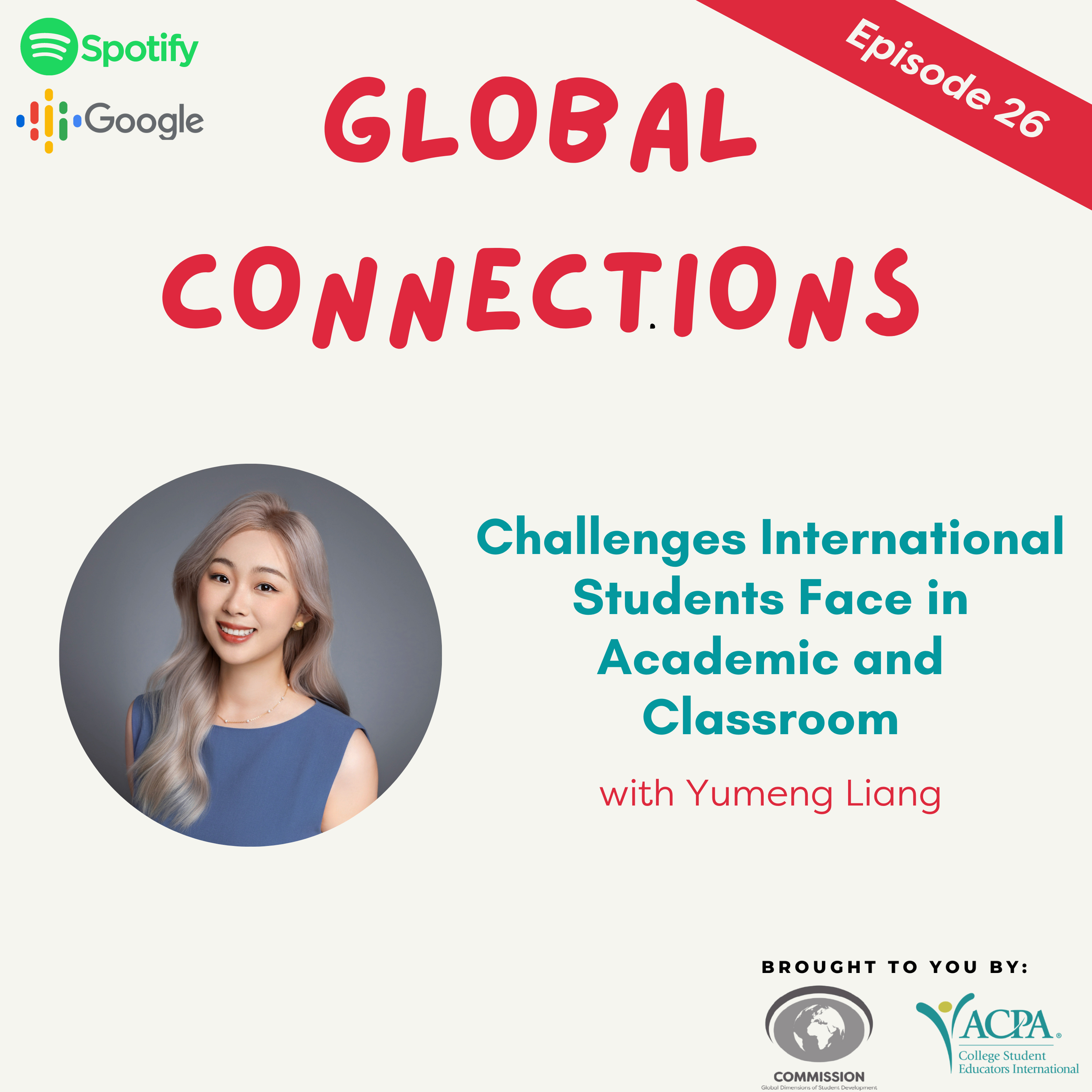#26-Challenges International Students Face in Academic and Classroom
SUMMARY KEYWORDS
international students, research, students, discussion, classroom, cultural sensitivity, instructor, attitudes, intercultural communication, peers, inclusive social science
SPEAKERS
Yumeng Liang, Lixing Li

Lixing Li 00:00
Hello, everyone. Welcome back to our global connection podcast channel. I am your host Lixing. Today I’m very happy to invite Yumeng Liang to talk about her research on challenges international students face in academics and the classroom. Yumeng is a third-year PhD student in higher education and student affairs. Originally from China, she is passionate about three main research areas: international students, artificial intelligence, and institutional research. She is particularly interested in enhancing the experiences of international students exploring the potential of AI in education, and using data-driven insights to improve higher education institutions. These areas strive for the academic journey, and she’s excited about the possibilities they hold for future education. Welcome Yumeng! We’re very happy to have you joining us today.
Yumeng Liang 00:54
Thank you, Lixing, for inviting me to the podcast! I feel I’m very honored to share my research experience to the other audience, the educators and the young professionals today.
Lixing Li 01:07
Yeah, and I am very much looking forward to our conversation today. This topic is very interesting to me. And I’m sure also very interesting to many of our audience. I’m curious what personal experiences have influenced your choice to pursue this research? And what motivates your passion for it?
Yumeng Liang 01:28
Yeah, that’s a good question. So today, I want to leave you diving into the world of higher education and intercultural communication. And I want to mention my research topic is class participation of international graduate students in social science. And before I jump into my research, I want to share with you guys what got me on this journey and why I am so passionate about it. So like many of you have always been fascinated by the diverse mix of students in grad programs, especially in social science. And you say, according to the open door, 2021 years here, I’m gonna get give some data. nearly 20 of the 20 percentage of international students coming to the United States choose to pursue their graduate study in social science. That’s a significant chunk of the academic landscape, isn’t it? So now, we’re really sparked me interest was the potential of international students to enrage the academic and cultural capstreet of our campuses. So as you all know, I am an international student, and I can tell where brainy are the unique perspectives, different words, wheels, and diverse experiences that in theory should make our classroom vibrant hubs of intercultural exchanges. So be an international student here in the United States has given me firsthand experience of the unique challenges we all face in the classroom setting. When you think about international students, you will find a picture that international students they are on the quieter side during classroom discussion. And we might not often take up the role of discussion leadership, and our class interactions might not be as frequent as we’d like them to be, and leading to a sense of limited engagement in the classroom as well. So, why this happened? Guess Guess what? So, we all know that intercultural communication is important. However, because of those phenomena that I mentioned before, I realized that just bringing international students and domestic students together doesn’t guarantee effective intercultural communication, right. So, you see, there are many challenges, language barriers, cultural differences, and even the teaching style and attitudes of instructors and domestic students themselves play a role. So, the existing research out there highlight the struggle that international students face when the when it comes to a classroom discussion, and they often feel that their ability to participant is hindered by factors, like language barriers and the cultural differences, but hear it the same. There’s not just about their skills, it’s about the active environment in the classroom right? By the domestic students is not only themselves, let’s get back to the classroom, we’re talking about the place where intercultural communication is a key, especially in a graduate-level social science class, which has a lot of reading and a lot of interaction, a lot of discussion based on different theories. And those programs require active participation as you all know. And it’s here that students, both international students and domestic students may face various challenges. So, okay, good study has shown that effective communication among those group doesn’t always happen. And that’s often because of the dominance of the US context. And the sheer number of domestic students, the white supremacy, or something like that. But this is important, there’s hope. Yeah, we should definitely acknowledge there’s hope. And there’s not all due to teaching style discussion structure and instructors attitude towards inclusivity can create an environment where those intercultural exchanges thrive. So let’s talk about the gap in the existing research. Most of its focusing on the undergrad experience, specific word for ages or international student with your single course. And we all need to explore the experience of international students, graduate student from different countries in the social science disciplines. So here’s why my research comes. In my study, I aim to uncover unfavoured the factor that either help or hinder the participation of international graduate students in social science. So I asked two questions. It is also my research question. So first question is, what are the factors that put international students as these advantages when it comes to classroom discussion? The second is, what are the factors that actually boost their participation, and make those discussion more inclusive and enriching for everyone? So those are the kind of background of my research and why I am passionate about and how it inspired me to prompt the two questions for my research. I hope it is helpful so far.
Lixing Li 07:07
Wow, this is really, I really amazed and this is very meaningful topic. I mean, as an academic advisor myself, I often heard about students classroom performance and all about things happening in the classroom, how would they get into the classroom engagement? How can they catch up with other students? Just like you said, students have different backgrounds, and even for domestic students, how to fill in. It’s definitely very meaningful. I love this topic. Love it! Thank you for giving us the information about the research the stories motivations behind it. And can you elaborate on your research methodology and theoretical framework that guided your study?
Yumeng Liang 07:53
Yes yeah, definitely. So here, I will briefly introduce the theory I’m I am using. So the theory I’m using called Darla Deardorff’s theory is back to 2006. Darla Deardorff came up with a great model for this. And it has four key parts. First, there are individual attitudes, like being open to other cultures, carers and respectful and those attitudes are the foundation of intercultural competency. And then when you’re in the cross-cultural situation, you start learning about other cultures by listening, observing and interpreting. And this knowledge makes you better at adapting and communicating with people from diverse backgrounds. And now here is the cool part, Darla Deardorff says, you can be a pro at cross-cultural communication by having either a good attitude or solid cultural knowledge? So, how does all those theory connect to our study on the classroom discussion? Well, we are digging deep to figure out why international students might struggle to communicate efficiently in the classroom. And this is because of their attitude or lack of cultural knowledge. So that’s the big question we’re exploring. So this is why we’re using the theory. And in terms of the methodology, we are using qualitative descriptive model cases approach. That’s just a fancy way of saying we are divided into the detail and looking at the real cases and describing what we found. So now who is the spotlight here? So who is the participant? Our participants are international graduate students, a diverse bunch from different countries are pursuing their dream with graduate degree in social science. And they’ve been in United States for at least a year or more. So they have some experience, study or visiting other for any countries, so they know a thing or two about crossing boundaries. And as for the collecting data, we’ve had some great one on one discussion with those international students. And we asked them about their experience based on their based on our research questions, and each interview took about 60 or 90 minutes. When this participant permission, we recorded them. This is how we did our research. And when it came to analyzing, or the juicy data, we use Darla Deardorff’s intercultural competency model as our trusty guide. Specifically, we look at weather attitudes like respect and openness, cultural sensitivity, and cultural awareness of domestic peers and instructor influence, international student participation in classroom discussions, and to keep things on the app and app we follow the principle of investigator triangulation, which basically means for researchers, including yours truly work together to code, the interviews. And we use some called the constant comparative method to refine our initial codes and build some themes. And this is how we conduct our research. And I hope this whole methodology or the theoretical framework can help the educator or future researchers to build out their own research, too
Lixing Li 11:42
Absolutely absolutely love it. Yeah. Thank you so much for sharing. What are the key findings and practical applications of your research?
Yumeng Liang 11:52
Oh, yeah, this is very important part of our research. And we’ve developed four themes based on those interviews, discussions and methodology, the theoretical framework, and for now we have four themes. The first theme is convert ethnocentrism. So first up, we’ve got convert ethnocentrism. Now, what is that? So, it is when domestic students and the faculty unknowingly show a preference for the American in the classroom, and our international student participant told us that discussion often revolves solely around the US topic was little room for other perspectives. Imagine being an international student bringing with insight about your home country, but never get in the chance to share them. That’s what our participation feel and their international perspective wasn’t, won’t be valued. And it’s like, it is a feeling like you’re not belong here and that your voice didn’t matter.
Lixing Li 13:04
That is sad.
Yumeng Liang 13:05
It is. The second theme is contextualized knowledge difference. So what is that? We got the contextual knowledge difference here the scoop, instructor and the domestic students sometimes choose around terms, events, and even sleds that familiar only to them. So I think as international students, you may feel the same way. Because this can be like trying to read a book with a missing page and is tough to contribute to a discussion. When you’re not familiar with the term or slang or whatever they are talking about the event or US context thing. And our participation wish that instructor and peers would take a moment to clarify things, making the discussion more inclusive for everyone.
Lixing Li 13:58
I like what are you saying read the book of missing pages. Wow, this is so vivid, it’s definitely the challenge.
Yumeng Liang 14:05
Let’s talk about the imbalance of cultural sensitivity. Here is the interesting twist. International students often find themselves being super sensitive to the cultural nuances of their domestic peers. They’re like observer carefully, gauging reaction and comments to make sure they fit into the US academic environment. But here is the catch. Sometimes the sensitivity can be backfire. For example, one participation who speak English with with non-US accent feel very frustrated when she was asked to repeat herself, because domestic student doesn’t understand her accent. And she said she saw it is lack of efforts or her domestic peers hard to understand her even though they’d been in the same class for a while. So this imbalance in cultural sensitivity can lead to misunderstanding and make international student feel less motivated to engage in the discussion. Yeah, this is also very important to have a balanced cultural sensitivities towards not only international student and domestic students.
Yumeng Liang 15:23
And the theme four is the appreciation for the international perspective. Here is the silver lining when instructor and peers show genuine interest in international students international students point of view, it can create an inclusive classroom discussion environment. And this includes effort to clarify meanings and checking with international students to ensure they are following along. Such cultural and linguistic sensitivity can make international students feel valued and motivated to participant. But remember, it is not about forcing them into the classroom discussion. It is about creating an atmosphere where their contribution or appreciate it. So like a lot of our participant really wants to have an inclusive classroom discussion atmosphere that appreciate their efforts on sharing different perspectives. So this is how we found our four themes contributing to our international students classroom discussion.
Lixing Li 16:37
Great wow, I am really amazed to hear that those findings are definitely very helpful. Even though I’m not teaching to the students, I kind of learn some takeaways for my advising, for my advising meetings with my students. This is great. Thank you for sharing. My next question is what steps, what strategies can individuals take to enhance the classroom experience for international students?
Yumeng Liang 17:05
Here I want to share some practical applications we can take from those findings. So first, as an instructor, and institution can take steps to diversify classroom contents including topics, a examples from different countries and cultures to create a more inclusive discussion space. And secondly, maybe providing context and be mindful of international student honors standing can go along go a long way in making discussion accessible to everyone. And also, it is very crucial to balance cultural sensitivity. Just as I said, international students should be encouraged to engage in discussion without fear of misunderstanding, and domestic students can also make an effort to understand their peers better, like their accent. Lastly, showing appreciation for the international perspective can be a really good game changer, and instructors and the peers who actively seek out and value their point of view can create an environment where you can national student feel motivated to participate and contribute their unique insight. So this is how, like an instructor in domestic students in that institution can contribute to. So I hope the environment can be changed and the international students can have a better atmosphere to express themselves.
Lixing Li 18:41
I hope so too. I really love the steps and strategies. I think they’re very helpful. Do you have any advice for international graduate students studying and living in the US?
Yumeng Liang 18:51
Oh, yeah, absolutely. I am an international student. And I’ve been a us for four years. So it’s been very hard to, to adapt to a new culture. So what I want to say is, don’t be shy about speaking up. And you are your own word, and embrace opportunities that come your way. Also advocating for yourself and your voice is a key to success. Yeah, just don’t be shy.
Lixing Li 19:24
Don’t be shy. Yes. Thank you so much. Thank you, Yumeng for joining us on the podcast. Your insights, and sharing are invaluable and definitely make this conversation truly special. And we wish you all the best in your future research endeavors. And may your paths be filled with continuous success in inspiration. And for our audience today. If you’re interested in learning more about Yumeng’s research, feel free to follow Yumeng Liang on LinkedIn. And we’re gonna share that information on our website. And thank you again for joining us Yumeng!
Yumeng Liang 19:56
Thank you. So thank you all for listening to the podcast. So thank you all for sharing my research with me. I hope you guys have a really really nice year academic year.
Lixing Li 20:09
Thank you!



Recent Comments